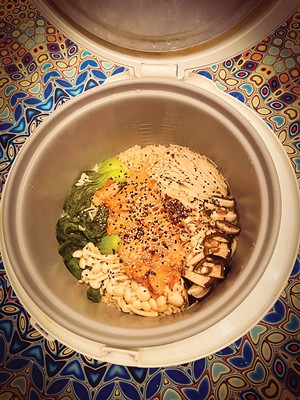The late Roger Ebert was an unlikely enthusiast of the electric rice cooker.
A Pulitzer Prize-winning film critic for the Chicago Sun-Times (and Urbana native), Ebert had a true passion for food and cooking. My wife's cousin, Carolyn, who knew Ebert well, shares fond memories of how he loved going to restaurants with a big group and ordering family-style for the table, especially Greek and northern Chinese cuisine. But when he cooked at home, he was a big fan of the rice cooker. He used it not only for cooking rice but also to create entire meals in this humble appliance.
Ebert's culinary adventures with the rice cooker didn't stop at home. He would bring his rice cooker to the Sundance Film Festival where he would use it to prepare his meals during his busy movie-viewing schedule. According to his wife: "We used to take the rice cooker almost everywhere we went."
After the loss of his lower jaw from cancer surgery left him unable to speak or eat solid foods, Ebert turned to the internet and started a blog. His post about rice cookers prompted hundreds of readers' comments, including recipe submissions. The response inspired him to write The Pot and How to Use It: The Mystery and Romance of the Rice Cooker, with his recipes and insights on using the appliance to its fullest potential. More than just a cookbook, Ebert shared his insights and observations on why and how he enjoyed cooking, and what it was like for him to lose his jaw to cancer.
Ebert begins simply: "First, get the Pot. You need the simplest rice cooker made. It comes with two speeds: Cook and Warm. Not expensive. Now you're all set to cook meals for the rest of your life on two square feet of counter space, plus a chopping block." He expresses his wonderment for the Pot: "How does it know? There are no dials and settings on the Pot. As far as you can tell, there is only a heating element beneath. There doesn't look like room for anything else to hide. How does the Pot know how long to cook the rice? It is a mystery of the Orient. Don't ask questions you don't need the answers to. The point here is to save you some time and money."
For the curious, the basic rice cooker consists of a plastic and metal container with a heat source on the bottom and a removable, nonstick metal pot. When water comes to a boil and turns to steam, the temperature in the pot will begin to rise. The built-in thermostat with a magnetic switch tracks the temperature of the bubbling mixture of rice and water. When the temperature reaches a certain point, known as the magnet's Curie point, the magnet ceases to be magnetic, which releases the switch and signals the cooker to switch to "keep warm." The rice cooking process takes 20-35 minutes and any ingredient that will be fully steam-cooked within that time range can be included in the rice cooker – foods with cooking times longer than rice require precooking.
Expanding the boundaries of the rice cooker wasn't unique to Ebert. In Japan, takikomi gohan is a popular one-pot dish made by cooking rice in a seasoned dashi broth in a rice cooker with vegetables and meat or fish. In Japanese, takikomi means "boiled with" and "gohan" means "rice." The rice absorbs the flavor of the ingredients and becomes moist and tender. Takikomi gohan is essentially a Japanese pilaf.
Takikomi gohan with salmon
This dish is traditionally made in a rice cooker but can also be made on the stovetop. Takikomi gohan is a delicious and versatile dish and is a perfect meal for a busy weeknight. It is a great way to use up leftover vegetables and meat.
Serves 2
Ingredients:
1 cup of medium or short-grain rice
1-2 salmon filets
2 tablespoons white (shiro) miso
2 tablespoons soy sauce or tamari
1 tablespoon mirin
2 teaspoons maple syrup
1 teaspoon sesame oil
1 teaspoon fresh ginger, grated
1 package enoki mushrooms
1 package beech mushrooms (Shimeji or buna-shimeji)
Baby bok choy or baby broccoli
1 tablespoon unsalted butter
Garnishes - any or all of the following:
Sesame seeds
Furikake
Sliced scallions
Chili crisp
Preparation:
Wash the rice in a fine mesh strainer until the water runs clear.
Inspect the salmon for pin bones. Gently run your fingers over the flesh. If you feel pin bones, firmly grasp them with tweezers and pull them straight out. Then remove the skin: place the salmon skin-side down on your cutting board and with a broad, flexible knife, make a small downward cut through the flesh, but not through the skin. Holding down the end of the fish with your other hand, turn your knife horizontally and carefully slice away from you between the flesh and the skin. If you have trouble holding onto the end of the skin, dip your fingers in water, then salt. This will keep your fingers from slipping. If you don't feel comfortable removing the salmon skin with a knife, you can use boiling water. On a wire rack over your sink, place your salmon skin-side up. Pour some boiling water over the salmon skin until it starts to release from the edges. Try not to cook the flesh too much. Wait a few seconds, then peel off the skin.
Prepare the marinade: In a small bowl, thoroughly combine the miso, soy sauce or tamari, mirin, maple syrup, sesame oil and grated ginger. Thoroughly coat the salmon filet and marinate for 30 minutes.
Make the dashi: Bring 1 ½ cups of water to a boil, reduce to a simmer, and add 1 ½ teaspoons of Hondashi Instant Dashi. Simmer for 3 minutes and set aside.
Prepare the vegetables: Trim off the root ends from the mushrooms and cut the bok choy or broccoli into manageable pieces.
To the rice cooker, add the rinsed rice and dashi. Arrange the mushrooms and greens in neat piles on top of the rice. Remove the salmon from the marinade and drizzle the marinade over the mushrooms and greens. Place the salmon on top of the vegetables. Place the butter on top of the salmon. Close the rice cooker, and push down the "cook" switch. When the cooking cycle is finished, and the rice cooker switches to "warm," open the rice cooker, fluff the rice with a fork and add the garnishes: sesame seeds, furikake, sliced scallions and chili crisp.


















